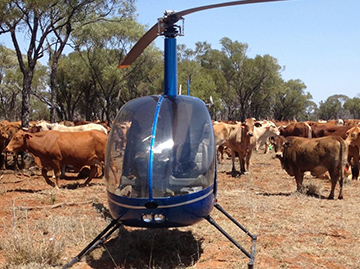Late afternoon glare and light refraction affected the pilot’s vision and depth of field, with tragic results.

On 28 May 2015, the pilot of a Robinson 22 helicopter, registered VH-HRW, was engaged in aerial mustering operations about 64 km north-north-east of Mitchell, Queensland. Late in the afternoon the helicopter’s tail rotor struck the branch of a 7 m‑high dead and defoliated tree, the pilot lost control of the helicopter and it collided with terrain. The helicopter was destroyed and the pilot, the sole occupant, was fatally injured.
The ATSB found that the pilot was appropriately qualified and flying due west in a serviceable helicopter at low level. The sun was to the north-west and about 13°–15° above the horizon at that time. The helicopter’s tail rotor collided with the upper branch of an isolated tree. That collision separated a portion of the tail rotor blades, leading to the remainder of the tail rotor and the helicopter’s horizontal and vertical stabilisers and tail rotor gearbox also separating. The pilot could not control the helicopter and it collided with terrain.
Given the conditions, it is likely that sun glare and the darkened backdrop of a tree-lined dry creek bed affected the pilot’s vision and perception, and therefore ability to identify the isolated tree. Despite the pilot wearing a helmet that was fitted with sun visors, the ATSB could not determine whether the visors were lowered at the time. In any event, it is likely that the pilot did not see the tree, or misjudged its height and/or its distance from the approaching helicopter.
The ATSB did not identify any pre-existing mechanical defects and established that, at the time of the accident, the helicopter was likely serviceable. The helicopter was fitted with a three‑point safety harness and bladder‑type fuel tanks. These tanks decrease the risk of a post‑impact, fuel‑fed fire. Despite these additional safety features, and the safety benefits possible from the pilot wearing a helmet, the accident was not survivable due to impact forces. A number of unrestrained items in the cabin increased the risk of injury as a result of those forces.
Safety message
Low-level aerial mustering operations are an inherently high-risk activity. When conducting this type of operation, pilots need to consider the environmental conditions as part of their flight planning and operational risk assessment. The ATSB and the Civil Aviation Safety Authority have released a number of publications illustrating the risks associated with this type of operation that provide guidance and strategies for mitigating those risks.
Read the final report: Collision with terrain involving Robinson R22, VH-HRW, 63 km north-north-east of Mitchell, Queensland, on 28 May 2015


